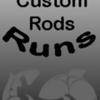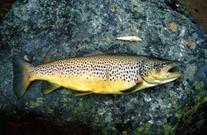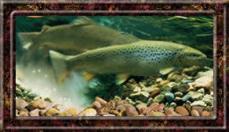Species Profile Brown Trout
German Brown Trout, German Trout, English Brown Trout, Von Behr Trout, Lochleven
Trout, European Brown Trout, Truite, Breac, Gealag, Searun Trout, sewien or
Brownie are just a few of the many names given to Salmo trutta. But by any
other name Salmo trutta is still our beloved BT or Brown Trout.
Brown TroutBrown Trout are found in water through out the U.S. where 55 to 65 degrees F waters are normal. Although the optimum temperature range for Brown Trout is 50 to 60 degrees F, browns can tolerate water up to 70 degrees F. Brown Trout are typically found in cold to cool water streams, rivers and lakes from the smallest mountain brook to the Great Lakes and the Atlantic Ocean. However in large still bodies of waters Brown Trout are typically found near shore and with-in tidal estuaries, and shy away from open water. Browns are a highly adaptable species and coupled with their wariness are often the only fish left in a put and take stream long after opening day has come and past. Many stocked Brown Trout will winter over and begin to spawn the following year, in all but the poorest quality waters.
Brown Trout Life history:
Brown trout are typically fall spawners and will begin spawning runs as early
as September on some major rivers. Once temperature reach the mid to high
40's browns will seek out gravel and begin spawning. Females will dig redds
and deposit 4,000-12,000 eggs which one or more males will fertilize. Eggs
will hatch the next spring and for the first few weeks the young will feed
off the remaining egg sack. Brown Trout
As the young mature they will begin feeding on insects and small crustations.
As their size grows so does the size of their food items, which now includes
crayfish, mice birds, frogs and fish. Browns feed heavily at night and have
been seen feeding on bats that have mishappenly fallen into the water.
Searun and Migratory Browns:
Although highly adaptable Brown Trout are also very opportunistic feeds. On
many waters the Brown Trout's diet consists heavily of other smaller fishes
and trout. Resident Brown Trout can and will quickly wipe out a population
of smaller fish on many small bodies of water. Although genetics may account
for Brown Trout to become migratory it is widely accepted that lack of sustainable
food source is one possible reason for Brown Trout to migrate. One can see
this occurrence in the Searun Trout streams of New England. New England Searun
streams are often little more then sandy tidal stretches running through marshes.
Often these creeks are devoid of structure and hold only a limited seasonal
food source. In cases like these creeks Searuns will live and feed in the
estuary portion of creek and only enter the creeks during spawning periods,
these fish are termed anadromous as they live in salt water and spawn in fresh
water.creeks Much the same can be said of small streams and creeks located
in the Great lakes. Often they are too short, too low in the summer or do
not offer enough of a food source for the Brown Trout. Because of one or another
of these reason Lake Ontario receives Brown Trout fingerling from the creeks
and streams ever spring, where they live and feed until they are ready to
spawn, fish like this are called potamodromous as they migrate within fresh
water only. From an anglers prospective it has been noticed that the waters
with the worst summer conditions will often have the best fall fishery, with
the Oswego being a great example.
Brown Trout Identification:
Brown trout are generally olive to brown in overall color and tone. Typically
the back and upper 13 of the body are dark brown to a gray brown. Lake specimens
typically have silver lower sides with river fish having yellow to yellow
brown sides. Large dark spots over the body of the fish surrounded by a halo
typifies the Brown Trout, however in lake fish these spots may be subdued.
Brown Trout will have reddish-orange or yellow spots scattered on the sides.
The bellies of these fish can range from almost pure white to a yellow. Male
Brown trout making a spawning run will typically exhibit vivid colors and
a well develop kipe. Fresh lake run Brown trout are often confused with on
of their relatives the Atlantic Salmon.




